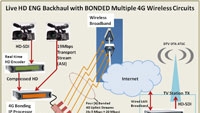JVC proposes bonded 4G to replace microwave ENG vehicles

While President Barack Obama continues to look for broadcasters to vacate some of their airwaves for broadband and other wireless technology use, JVC wants stations to know that that same spectrum can be an efficient way to transmit news shot in the field.
As a prelude to NAB, JVC is promoting the viability of using bonded multiple 4G uplink streams as a replacement for BAS microwave systems in HD ENG vehicles for local news. The company has posted a new white paper on the subject as part of a “Countdown to NAB 2011” series on its website.
Dave Walton, JVC assistant vice president of marketing and communications, said he hopes the series will encourage discussion at NAB.
“With ‘Countdown to NAB 2011,’ JVC is sharing research with broadcasters that could influence or change the way they produce news in the near future,” he said. (See video.)
The first report in the series, which has been posted to the new ProHD Executive Report page, discusses why live HD ENG is a competitive necessity and whether a 4G-bonded backhaul is a cost-effective way to deliver it. In the report, JVC compares the cost of ENG microwave vehicles against the cost and viability of 4G-bonded backhaul to the station. While microwave vehicles typically must reach the location and the raised mast for on-site connection, the solo ENG journalist with bonded 4G wireless can dial up the station as he leaves the parking lot.
“The HD ENG car is in ‘live contact’ with the TV studio for the duration of the assignment even while driving (no 25ft mast concern), except (of course) in any 4G problem coverage areas. There is no need to hoist and lower any microwave mast! And for ‘delayed live,’ the HD clips may be transmitted back to the TV studio while the HD ENG car drives from one location to the next!” the report states.
JVC argues that stations can save between $10,000 and $30,000 by not needing to invest in a separate, expensive real-time HD encoder unit for each HD ENG vehicle. It suggests using the 19Mb/s TS/ASI output from ProHD camcorders to feed live into the 4G-bonding IP processor to accomplish 4G-bonded backhaul.
Get the TV Tech Newsletter
The professional video industry's #1 source for news, trends and product and tech information. Sign up below.
Although it said the costs are “speculative” at this time, JVC said each HD ENG vehicle needs to “subscribe” to four 4G wireless USB sticks to achieve broadcast-quality service. Assuming that an unlimited bandwidth use subscription costs $150 per month for each of the four circuits, the total cost for the 4G-bonded backhaul will be $600 per HD ENG vehicle per month.
But will 4G-bonded systems work reliably?
“There are several variables before 4G-bonded backhaul can work (for live, local broadcast-quality HD ENG video), the most critical being the availability of sustained UL at 5Mb/s in many markets around the U.S.,” JVC wrote. If the speed in a market is half that, the company said, the number of 4G cards can be doubled.
The paper concludes that the viability of such systems must now be tested market by market between the four major mobile providers.
“The viability for 4G-bonded HD ENG backhaul in your DMA can only be established by field testing, particularly as relates to your important requirement that live HD ENG picture quality shall substantially match your HD news studio picture quality. 4G-bonded HD ENG backhaul is an interesting emerging technology requiring serious reviews by the TV broadcasting industry,” JVC wrote.
